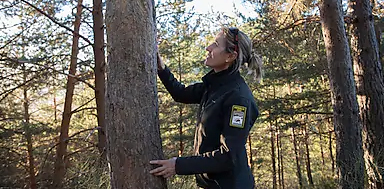As the climate changes, ecosystems around the world are also changing. A new study published by scientists at the Pacific Northwest National Laboratory (PNNL) suggests that these changes are causing trees to become smaller and younger. Rising temperatures are a source of stress for trees. Source: Timberbiz
Matti Maajärvi, Senior Specialist of Global Forest Affairs at UPM Forest, says that as the climate changes, “the frequency of negative natural phenomena – such as extreme droughts, forest fires and mass outbursts of pests – can impact the forests adversely.”
The availability of water is, of course, a vital factor for trees’ survival and plays a big rolei n the average age and height.
“The taller a tree, the more energy it needs to obtain water and to pump it throughout the branches. Younger trees are often more vital, while shorter trees save energy. In the last few years, we have noticed especially wild cherry trees dying in the middle of hotter than average summers without other reasons (fungi, beetles, etc.) – all because the water capacity in the soil was exhausted and the suction power of the roots wasn’t high enough to mobilise the last amount of water,” Alexander Mrkvicka, Deputy of the Department for Natural Resources at Vienna’s Forest and Agriculture Administration said.
The rates of climate change are not the same everywhere. Some areas are impacted more heavily than others and it varies between different eco-regions and tree species as to how changing climate is impacting their growth.
An increase of atmospheric CO can accelerate tree growth but, on the other hand, a warming climate creates temperature and water-stress for trees. This in turn can slow the growth down and because forests are complicated systems, the success of trees depends also on other species and how they respond to changing conditions. Even a small area like the city of Vienna has very different conditions.
In addition to environmental conditions, unsustainable wood harvesting and land conversion activities have caused deforestation, forest degradation and loss of natural, old growth forests, which is directly affecting the age and height of trees.
There are several things that can and are being done to address this issue. Sustainable forest management (SFM) practices and the regeneration of harvested areas are of utmost importance. It is important to address all the vital functions of a forest ecosystem in a way that fits in with the natural conditions of the region.
“Sustainable forestry does not cause deforestation or forest degradation. For example, in Finland and as part of SFM, some parts of the forests, such as buffer zones around waters, retention tree groups and key biotopes, are protected and allowed to develop naturally. It adds structural variation to forests. And sustainable forestry is not just about growing trees – it’s also about securing the carbon sinks of the forests and thus combatting climate change, which is one of the underlying reasons for this phenomenon, too,” Maajärvi said.
Mrkvicka agrees that SFM is crucial and underlines the importance of promoting the diversity of native tree species, which are adapted to the regional and local conditions, and not planting foreign species, which are declared “climate fit“ and often replace the diversity of native tree species for economic reasons.
Natural rejuvenation is also vital because it enables a high genetic diversity of young trees, in contrast to only planting seedlings. Genetic diversity means having the potential to adapt to new conditions. Last but not least, Maajärvi believes that we must do what we can to protect the remnants of natural forests that are still left.
Clear-cutting, however, is a more controversial topic. According to Mrkvicka, keeping forests as dense as possible is of great importance; for example, clear-cutting or final felling of whole areas means no shade for the soil. This can lead to a rise in soil temperatures, which in turn results in a loss of humus, nutrients and water capacity, as well as an excess production of CO.
However, in boreal managed forests, clear-cut is a widely used method for forest regeneration. The basic thing, says Maajärvi, is that clear-cut areas are always regenerated and the new forest growth of these areas is secured. Clear-cuts are a part of sustainable forest management when done right, but it is important to note that they donot fit all forest sites.
“It is a totally different thing to make a clear cut in a primary tropical forest that will never recover than in a managed boreal forest landscape where surrounding forests always have similar stands available,” Maajärvi said.
Rising temperatures, less water available for trees and humanity’s oftentimes unsustainable forestry activities are stressing trees out, stunting their growth and reducing their average age. But well thought-through forest management has the potential to mitigate and, potentially, reverse this trend. Therefore, SFM practices, adapted to local circumstances, must be implemented across the world if we are to pass on beautiful, tall forests to the generations to come.






